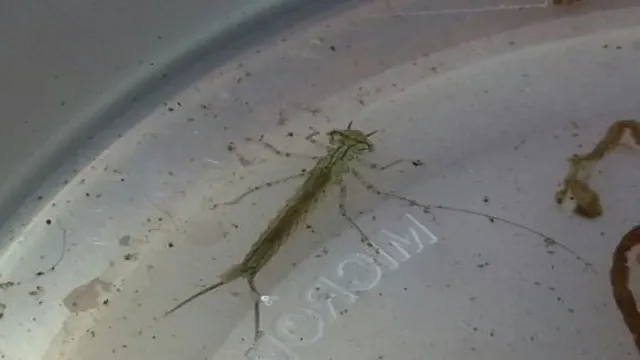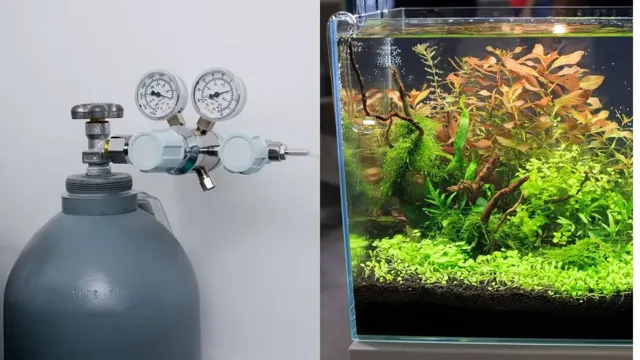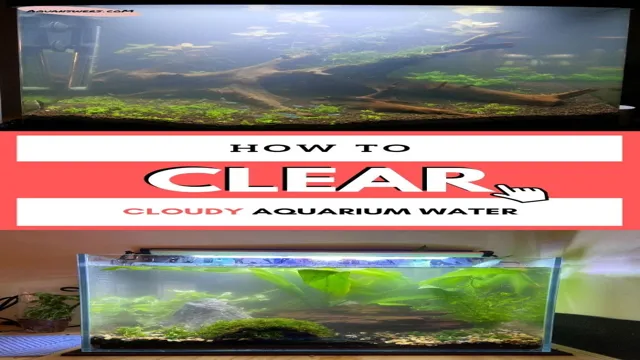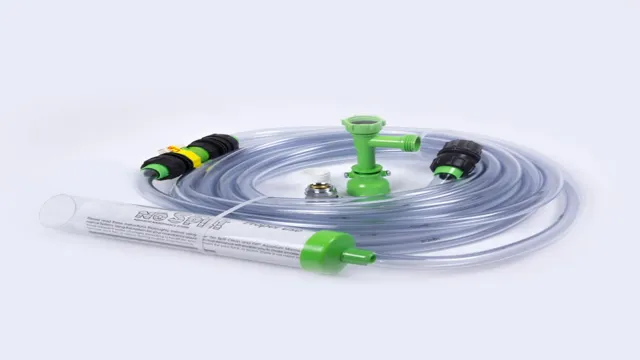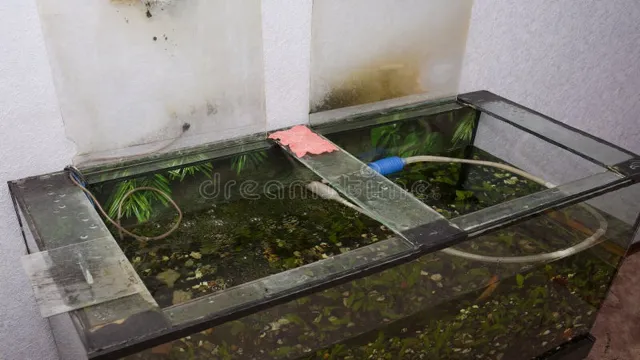Do you have an aquarium at home? If so, you know how important it is to keep the water clean and healthy for your fish to thrive. One of the biggest challenges that aquarium owners face is dealing with dragonfly larvae. These creepy crawlers can quickly become a nuisance, not only for your fish but for you as well.
Fortunately, eliminating dragonfly larvae in your aquarium is not as difficult as it may seem. With a few simple steps, you can say goodbye to these pesky little bugs and ensure your aquarium remains a happy and healthy environment for your fish to live in. So, let’s dive in and explore the best ways to get rid of dragonfly larvae in your aquarium, once and for all.
Understanding Dragonfly Larvae
If you’re experiencing an infestation of dragonfly larvae in your aquarium, there are a few things you can do to get rid of them. These larvae are known to be aggressive predators, feeding on small fish and other aquatic organisms. One method to get rid of them is by physically removing them from the aquarium using a fine mesh net.
Additionally, you can try adjusting the water temperature and pH levels as dragonfly larvae tend to thrive in warmer water. Another option is to introduce natural predators to your aquarium, such as fish or other aquatic creatures that will prey upon the larvae. Remember, prevention is key, so monitor your aquarium regularly and keep it clean to deter dragonfly larvae from laying their eggs in the first place.
By taking these steps, you can effectively rid your aquarium of dragonfly larvae.
Identifying Dragonfly Larvae
Dragonfly larvae are fascinating creatures that are often overlooked in favor of their adult counterparts. However, understanding their life cycle and unique features can provide important insights into the ecology of freshwater ecosystems. One of the key characteristics of dragonfly larvae is their elongated, segmented bodies, which are adapted for life underwater.
They also have large, powerful jaws that they use to capture and eat prey such as small fish and aquatic insects. To identify dragonfly larvae, it is important to look for distinct physical features such as gills on their abdomen and a long, pointed tail. These features can vary among different species, so it is important to consult field guides or experts to accurately identify a particular larvae.
Overall, learning about dragonfly larvae can deepen our understanding of the intricate web of life in freshwater ecosystems and inspire us to protect these vital habitats for future generations.
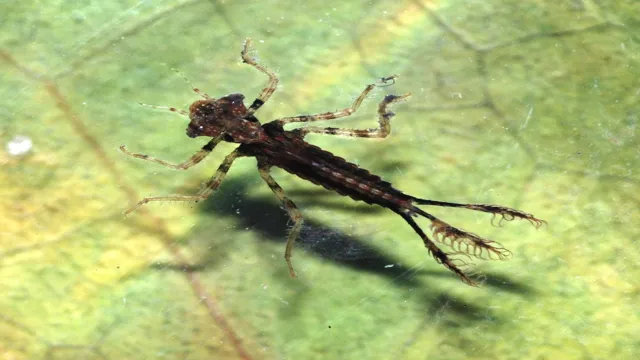
Lifecycle of a Dragonfly
Dragonfly larvae undergo a fascinating process as they mature and transform into adult dragonflies. Also known as nymphs, these larvae spend the majority of their lives in water, typically found in ponds or slow-moving streams. The larvae resemble miniature versions of the adult dragonfly but have gills for breathing underwater and six legs that are used for swimming and crawling.
As they grow, they molt several times, shedding their exoskeletons, which allows for further development. The nymphs are voracious predators, feeding on a wide variety of aquatic insects and even small fish. When the time comes, they climb onto a nearby surface, split their skin, and emerge as adult dragonflies with beautifully colored wings.
These insects are essential for the ecosystem, controlling insect populations and serving as important food sources for fish and birds. Understanding the life cycle of dragonflies provides a glimpse into the fascinating world of nature and all the wonders it holds.
Why Dragonfly Larvae Are Harmful to Your Aquarium
If you have an aquarium, one of the most frustrating things can be finding out that dragonfly larvae have infiltrated your tank. These pesky insects can be harmful to your fish and aquatic plants, as they prey on small creatures and can damage roots. Additionally, once they mature into adult dragonflies, they will fly around the room and may cause havoc during feeding times.
So, how do you get rid of them? One method is to remove any objects in the tank that they may be using as a breeding ground, such as rocks or plants. Additionally, keeping the water clean and at the correct temperature can deter them from laying their eggs in the tank. However, if the infestation is severe, you may need to introduce a predatory fish species that can eat the larvae. (See Also: How to Grow Aquarium Plants from Cuttings: A Complete Guide for Aquatic Plant Enthusiasts)
But, be cautious when introducing new species to your tank as they may have their own set of issues. Ultimately, the best way to deal with dragonfly larvae in your aquarium is to prevent them from entering in the first place by always checking any plants or materials before adding them to your tank.
Effects on Water Quality
If you’re into aquariums, you should be aware of the negative impact dragonfly larvae can have on your water quality. These little critters are harmful to your aquarium because they can eat smaller fish and insects, causing an imbalance in your tank’s ecosystem. Dragonfly larvae are voracious predators and won’t stop at just eating their prey; they can also excrete waste that can harm your fish and other aquatic creatures.
This, in turn, can lead to cloudy and murky water with an unpleasant odor and discoloration. It’s essential to monitor the population of dragonfly larvae in your aquarium and take measures to control their growth to ensure a safe and healthy environment for your fish. If you’re unsure about how to handle this issue, consult with a professional before making any changes to your tank.
Don’t let dragonfly larvae ruin your aquarium’s water quality; take control of the situation before it’s too late.
Effects on Your Fish and Other Aquatic Life
Dragonfly larvae can wreak havoc on your aquarium’s ecosystem. These predatory insects feed on small fish and other aquatic organisms, quickly reducing the population of your beloved pets. Moreover, dragonfly larvae are known to consume the eggs of fish and other invertebrates, causing reproductive issues in the long run.
They can also damage aquatic plants, leading to imbalanced oxygen levels and pH levels in the water. In addition to these effects, dragonfly larvae are difficult to remove once they have invaded your aquarium, as they are agile and can hide in tight spaces. It’s crucial to prevent these creatures from entering your aquarium in the first place by ensuring that your water source is clean and free of adult dragonflies.
By taking preventative measures, you can ensure the health and well-being of your aquatic pets and preserve the delicate balance of your aquarium’s ecosystem.
How to Get Rid of Dragonfly Larvae
If you have an aquarium and notice dragonfly larvae, don’t panic! There are ways to get rid of them. Firstly, you should remove any excess food or debris as this can attract them. Secondly, you can introduce fish that feed on larvae, such as guppies, mollies or swordtails.
These fish are effective at controlling the larvae population. Lastly, changing the water in the aquarium regularly can also be helpful. However, it’s important to note that dragonfly larvae are beneficial insects as they help control mosquito populations.
Therefore, it may be worth considering if completely removing them from the aquarium is necessary. With a little bit of effort and patience, you can successfully control the dragonfly larvae population without compromising the overall health of your aquarium.
Removing the Larvae Manually
Dragonfly larvae can be quite a nuisance in a pond or a backyard water feature, as they can eat other insects and even small fish. One effective way to get rid of them is by removing them manually. This process involves using a small net to catch the larvae and then placing them in a separate container.
It is important to wear gloves while doing this as dragonfly larvae have a strong bite. After removing all the larvae, it is important to clean the pond or water feature thoroughly. This will ensure that any larvae that may have been missed will not hatch and continue to grow.
Additionally, it is important to use a natural and safe method to prevent further larvae growth. One popular method is adding a layer of barley straw to the pond as it acts as a natural algaecide and helps reduce the larvae population. By manually removing dragonfly larvae and taking preventative measures, you can enjoy your backyard water feature without the fear of pesky larvae. (See Also: How to Fix Ammonia Spike in Aquarium: Tips to Remove Excess Ammonia)
Using Chemical Treatments
If you’re dealing with a dragonfly larvae infestation, chemical treatments can be an effective way to get rid of these pests. There are several types of chemicals that can be used for this purpose, including insecticides and larvicides. Insecticides work by killing adult dragonflies, while larvicides are designed to target the larvae specifically.
When using chemical treatments, it’s important to follow the directions carefully and wear appropriate protective clothing, as some chemicals can be harmful to humans and pets. It’s also a good idea to consult with a professional exterminator for the best approach to treating your particular situation. With the right chemical treatments and proper precautions, you can successfully eliminate dragonfly larvae from your property.
Preventing Dragonfly Larvae in Your Aquarium
If you’re noticing dragonfly larvae in your aquarium, it’s important to take action to prevent them from causing harm to your aquatic pets. First and foremost, you’ll want to make sure that your aquarium is clean and free of any debris or decaying matter that could attract dragonflies. Additionally, you may want to consider adding natural predators of the dragonfly larvae, such as damselflies or predatory fish like bettas, to your aquarium.
Lastly, you can also use insecticides or other methods to eliminate the larvae, though care should be taken to ensure that these methods are safe for your aquarium inhabitants. By taking these steps, you can help ensure that your aquarium remains a safe and healthy environment for your aquatic pets.
Maintaining Water Quality
Maintaining water quality in your aquarium is crucial to keeping your aquatic pets healthy and happy. One common issue that can arise is the presence of dragonfly larvae in your tank. These larvae can eat small fish and insect prey, causing harm to your beloved aquatic creatures.
To prevent dragonfly larvae from entering your aquarium, it’s important to make sure your tank is properly sealed and covered. Additionally, regularly checking your water source and any live plants or decor you add to your tank can also help prevent the introduction of these unwanted pests. By staying vigilant and taking proactive measures, you can ensure your aquarium stays healthy and free from harmful dragonfly larvae.
Avoiding Overfeeding and Overcrowding
When it comes to keeping an aquarium, it’s important to find the right balance between providing enough food for your aquatic creatures without overfeeding them. Overfeeding can lead to an overabundance of uneaten food, which can create a breeding ground for dragonfly larvae. These larvae can be harmful to your fish and other animals in your aquarium, so it’s important to take steps to prevent their growth.
One way to do this is by avoiding overcrowding your aquarium, which can lead to increased waste and uneaten food. Additionally, ensure that you are feeding your fish the appropriate amount of food for their size and species. It’s better to err on the side of caution and slightly underfeed than to overfeed and risk creating an unhealthful environment for your aquatic pets.
By taking these simple steps, you can help prevent the growth of dragonfly larvae in your aquarium and create a healthy, thriving ecosystem for your fish and other animals to enjoy.
Inspecting and Quarantining New Plants and Fish
If you’re new to aquariums and want to add some plants and fish, it’s essential to inspect and quarantine them before introducing them to your tank. One particular issue you’ll want to watch out for is dragonfly larvae, which can quickly become a nuisance. These larvae can hitch a ride on aquatic plants or even come in on fish from outside sources.
So, what can you do to prevent dragonfly larvae in your aquarium? One effective method is to place your new plants and fish in a separate quarantine tank for a few days. This will allow you to observe them for any signs of dragonfly larvae or other pests. It’s also a good idea to wash new plants thoroughly before adding them to your main tank.
If you do notice any dragonfly larvae, remove them immediately and dispose of them properly. Remember to be vigilant and take precautions when introducing new aquatic life to your tank to ensure the health and safety of your aquatic ecosystem. (See Also: How to Filter Aquarium Without Filter: DIY Methods for Clear Water)
Conclusion
If you want to keep your aquarium free from dragonfly larvae, there’s no need to slay dragons or wield a magic wand. Just follow these simple steps: keep your aquarium clean and well-maintained, remove any excess organic matter, and provide proper filtration and aeration. With a little diligence, you’ll be able to banish these pesky pests and enjoy a peaceful and dragonfly-free underwater kingdom.
“
FAQs
What are dragonfly larvae?
Dragonfly larvae are aquatic insects that are the juvenile form of dragonflies. They can be found in ponds, lakes, and other freshwater habitats.
Why are dragonfly larvae a problem in aquariums?
Dragonfly larvae can be a problem in aquariums because they can eat small fish and other aquatic creatures, and can also damage plants.
How do I know if there are dragonfly larvae in my aquarium?
You may notice dragonfly larvae in your aquarium if you see small, elongated bugs swimming around or on the plants or substrate.
How do I get rid of dragonfly larvae in my aquarium?
To get rid of dragonfly larvae in your aquarium, you can try removing them manually with a net or vacuum, or introducing other aquatic predators like fish or insectivorous snails.
Can I use chemicals to get rid of dragonfly larvae in my aquarium?
It is not recommended to use chemicals to get rid of dragonfly larvae in your aquarium, as this can harm other aquatic life in the tank.
How can I prevent dragonfly larvae from entering my aquarium?
To prevent dragonfly larvae from entering your aquarium, make sure to cover any openings and keep the tank clean to discourage their presence.
Are there any natural ways to get rid of dragonfly larvae in my aquarium?
Yes, introducing natural predators like fish or insectivorous snails can help get rid of dragonfly larvae in your aquarium. Additionally, maintaining a healthy ecosystem with proper filtration and plant growth can also discourage their presence.

